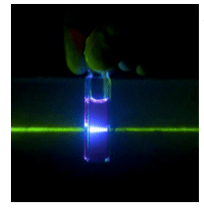Triplet-triplet excitonic upconversion
Triplet-triplet excitonic upconversion is the reverse process of singlet fission, and is a promising approach for generating high energy photons by combining two or more low energy photons. Photon upconversion shows promises in improving the PCE of single junction solar cells and in the near-infrared (NIR) sensitization of silicon-based devises for applications like biological imaging, 3-dimensional displays and photo-catalysis. Elucidating the quantum mechanical mechanism of photon upconversion is one of our research goals. Our results have demonstrated how the molecular geometry in diphenylanthracene (DPA) derivatives can affect the triplet fusion upconversion process.1-2 Improving the efficiency of triplet fusion upconversion in the solid state is a very active research area. Our results provide a strategy for developing efficient solid-state photon up conversion systems based on sensitizer-emitter mixtures.3
Photon upconversion in ptOEP/DPA mixture
- Gao, C.; Prasad, S. K. K.; Zhang, B.; Dvořák, M.; Tayebjee, M. J. Y.; McCamey, D. R.; Schmidt, T. W.; Smith, T. A.; Wong, W. W. H., Intramolecular Versus Intermolecular Triplet Fusion in Multichromophoric Photochemical Upconversion. Phys. Chem. C. 2019, 123, 20181-20187.
- Gao, C.; Seow, J. Y.; Zhang, B.; Hall, C. R.; Tilley, A. J.; White, J. M.; Smith, T. A.; Wong, W. W. H., Tetraphenylethene 9,10-Diphenylanthracene Derivatives – Synthesis and Photophysical Properties. ChemPlusChem 2019, 84, 746-753.
- Gao, C.; Zhang, B.; Hall, C. R.; Li, L.; Chen, Y.; Zeng, Y.; Smith, T. A.; Wong, W. W. H., Triplet Fusion Upconversion Using Sterically Protected 9,10-Diphenylanthracene as the Emitter. Chem. Chem. Phys. 2020, 22, 6300-6307.
